|
|
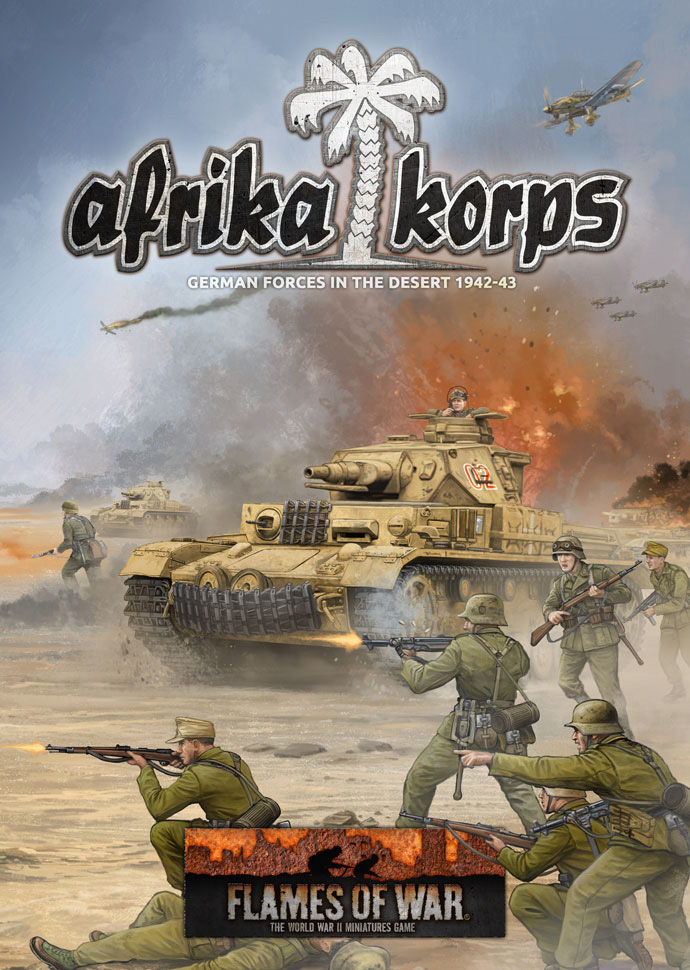 |
Afrika Korps Design Notes
with Phil Yates
In many ways, our latest two books, Desert Rats and Afrika Korps are a return to the beginning for me. Way back in 2004, two very similar books were some of the first army books published by Battlefront. In the intervening dozen years, many things have changed and we’ve learned a lot, and the latest incarnations of these books reflect this.
I’ll start with a quick look at each book in turn, then talk about some of the changes that the new Version of Flames Of War has wrought in them.
Check out Afrika Korps in the online store here...
|
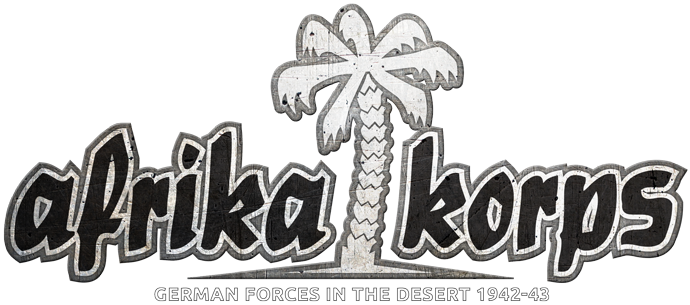 |
|
The Afrika Korps book follows the same pattern as Desert Rats, with its history interleaving that of the British book with focus on the fall of Tobruk and the retreat to El Alamein, the Battle of Alam el Halfa, and the fighting in southern Tunisia (where the Afrika Korps was joined by powerful Tiger tanks!).
The German special rules give most of their units the Stormtroopers rule allowing them to attempt a second Movement Order if they pass their first. This gives German units a tactical flexibility unrivalled by any other army. The Third Reich attribute reflects the (at the time quite justified) arrogance of the German soldiers, having just about conquered all of Europe, Russia, and North Africa in three years. They have a Last Stand rating of 3+, meaning they won’t quit, even when things are looking black.
|
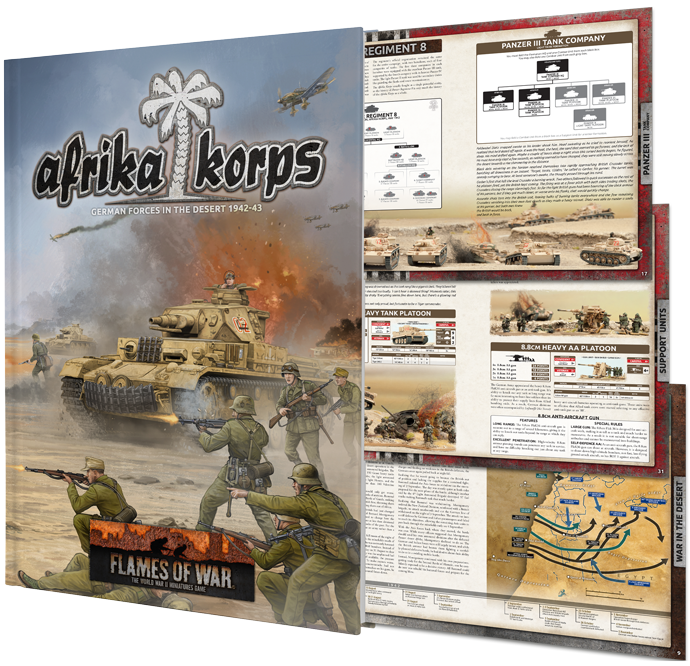 |
| Most of their tanks have the Protected Ammo attribute, making them very likely to remount from being Bailed Out, and the latest Panzer III short-barrelled 7.5cm model has the HEAT rule, allowing it to ignore the +1 penalty to penetration at long range, making it very effective when combined with its Firepower of 3+. |
 |
| Talking about the Panzer III, the book covers four different versions: the short and long-barrelled 5cm, the up-armoured long-barrelled 5cm, and the short-barrelled 7.5cm. Fortunately, there’s a detailed guide to the differences so you can tell them apart. The short-barrelled 5cm, the Panzer III (short 5cm) – the terminology matches that of German documents of the period, Panzer III (Kurz), covers all of the earlier models that made up the bulk of the force in the first half of 1942 and served on for the rest of the year and into the new year (mainly Panzer III H and J for the rivet counters like me!). |
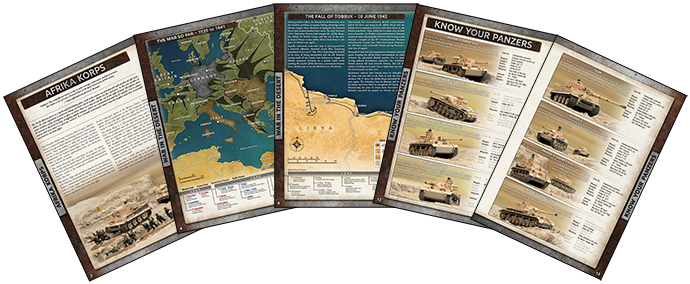 |
| The Panzer III (long 5cm) appeared in the Battle of Gazala and was predominant in the First Battle of El Alamein. Its long gun gives the tank 4”/10cm more range and Anti-tank 9 rather than 8. By the Second Battle of El Alamein, the Panzer III (up-armoured) – the Panzer III L for us techno-geeks – was the big hitter, combining the long gun with extra armour taking it to Front 6 rather than 5. This beastie is a match for anything the Allies can field! Just after Second Alamein, during the retreat, a batch of brand spanking new Panzer III (7.5cm) arrived (Panzer III N). These mounted the 7.5cm gun from the old Panzer IV (short) firing a new HEAT round to give them the anti-tank capability of the long 5cm (better at range), but lost some of the extra armour to keep the weight down. That’s a lot of choices for your main tank formation! |
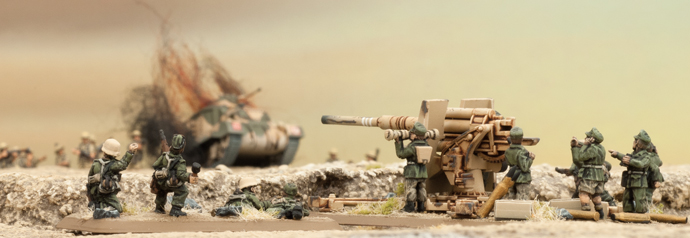 |
| If you want something a little bigger, the Panzer IV might be your thing. It’s got two variants: Panzer IV (short) and Panzer IV (long). The short-barrelled model (mostly the Panzer IV F, but some survivors of older types as well) is an artillery support tank, ideal for screening or knocking out anti-tank guns while the rest of your tanks do their thing. The long-barrelled model that replaced it (the Panzer IV F2 and G) was developed for anti-tank work as the Allies started fielding ever heavier tanks. Its gun has, even more, range than the long 5cm, and Anti-tank 10, so it’s no slouch in its designed role. |
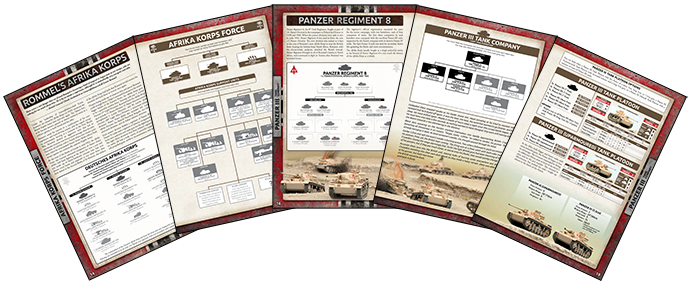 |
| Both types of tank companies can have light Panzer II tanks as well. These tanks were designed for training in the early 1930s, so have a one-man turret and light armour making them ineffective in combat except against light tanks. Instead, they were used to spearhead advances and locate the enemy ahead of the main body. Their Spearhead rule allows you to expand your deployment area (much like the armoured cars) at the start of the game. |
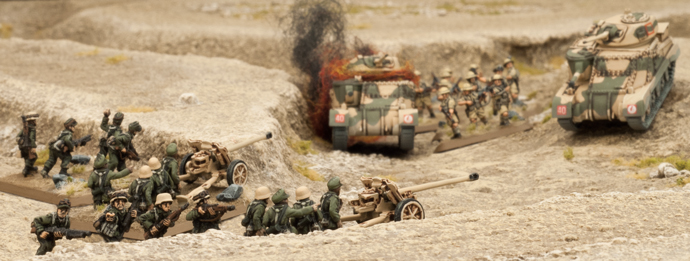 |
|
The Africa Rifle Company, the third and last formation that you can take, is like its British counterpart an all-arms grouping designed for desert warfare. Its three small infantry platoons are packed with machine-guns, including if you want it a heavy machine-gun (and even a mortar too), along with a heavy 2.8cm squeeze-bore anti-tank rifle. This hi-tech miniature anti-tank gun packs the punch of a 37mm gun in a much smaller package. Backing these up are three platoons of 5cm anti-tank guns, the equivalent to the long 5cm in the Panzer III. Historically, these guns were often part of the infantry platoons, but with their vastly different roles and characteristics, it works better to have them as separate units, although co-locating them for mutual defence is an excellent idea. You can also take light anti-aircraft half-tracks as part of your company as well.
|
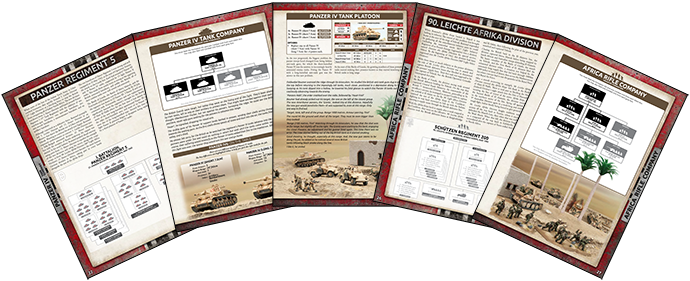 |
| The German support covers a wide range of equipment. You can have Marder self-propelled tank-hunters, four and eight-wheeled armoured cars, 10.5cm or self-propelled 15cm artillery batteries, anti-aircraft half-tracks, the dreaded ‘88’ heavy anti-aircraft guns (also excellent against tanks) and Stuka dive bombers. On top of these, you can also field the awesome Tiger tank. |
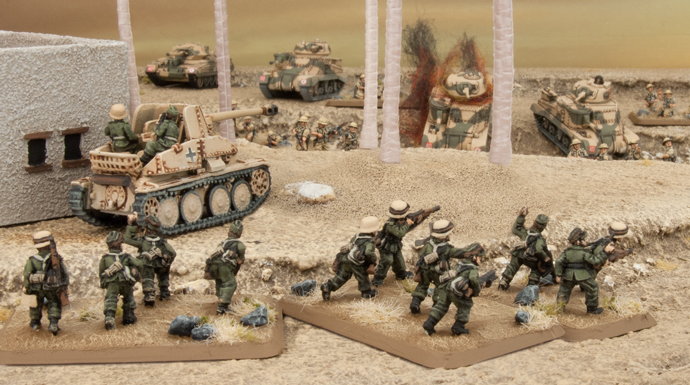 |
| The Tiger was supposed to be ready in time for the battles at El Alamein but was delayed, and then diverted to Tunisia to face the forces there. It wasn’t until the last stages of the fighting in southern Tunisia that the Afrika Korps finally got its own Tiger tanks during the retreat from Wadi Akarit and El Guettar. Although they were late in arriving, they made a big impact on the Allies when they did. The Tiger has massively thick armour (Front 9, Side 8, and Top 2) and mounts the ‘dreaded 88’ Anti-tank 14), with mobility to keep up with the light Panzers in combat (well almost anyway). |
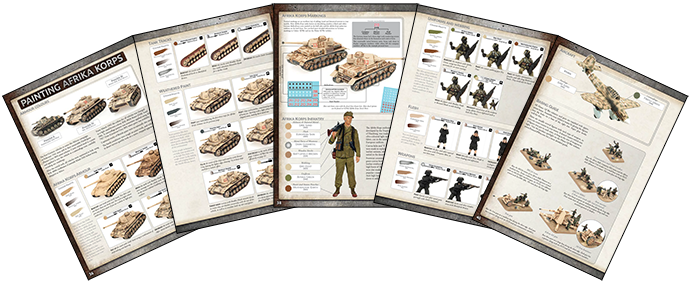 |
As the crews were hand-picked, the crews have the Tiger Ace attribute, giving them Last Stand and Remount ratings of 2+ (the later helped by their Protected Ammo). This means that they will usually fight to the death, a nasty prospect with such a tough and deadly beast. They also have the Escort Tanks special rule allowing each Tiger tank to have its own Panzer III as an escort. The extra Panzers make the unit more resilient and better able to tackle infantry and anti-tank guns, but the Tiger crews don’t expect their lighter escorts to survive long, so ignore their demise when it comes to Last Stand tests.
|
|
Organising Forces
As you can see, the structure of these forces is quite flexible. You can easily build pure tank forces or infantry combat teams, and you can also mix the two together by having a formation of each. If you want an almost-pure force, you can also take a single combat unit from a different formation as a support option. This allows you to field a tank company with an infantry platoon in support or vice versa.
Backing your formations with support like artillery, anti-tank, and aircraft gives you the ability to handle a wider range of threats. However, supporting troops are just that. If all of your formations run away, they’ll call it quits too. This makes taking a balance of hard-hitting combat troops and powerful support important.
|
 |
|
The new system for organising your force gives you unparalleled flexibility in creating your force while helping guide you towards a historically-accurate force. For the power gamers, they can put together almost any combination of equipment and troops they like. For the history buffs, the same flexibility allows them to create all the odd-ball forces they can dig out of the history books. While it is possible to build ahistorical forces, you need to push the envelope to come up with a combination that didn’t happen somewhere in the conflict.
If you are into historical research, this flexibility also allows you to build a wide variety of forces that aren’t directly covered by the book. For instance, a New Zealand Divisional Cavalry Squadron can be made by combining a small Honey Armoured Squadron and a Motor Company with plenty of Universal Carriers. If you prefer a little more guidance and a more formal organisation, we’ll be bringing out Command Card decks that include formations like the NZ Divisional Cavalry in a more formal way, as well as adding some of the more oddball equipment. In addition, you can use your models as equipment already in the book, so your Diana could use the Marder Tank-Hunter Platoon card for instance.
|
 |
|
As part of that flexibility, both forces can take allied units, American for the British and Italian for the Germans. You can’t use that capability yet, but once the US and Italian books arrive, new vistas open for you. At El Alamein, Rommel intertwined the German and Italian units to combine their strengths and mitigate their weaknesses. Your force can do this too. Likewise, in Tunisia, British and American forces found themselves fighting side-by-side in Blade Force and in the Battle of Kasserine Pass. Your allies can either provide a combat platoon, say Italian tanks supporting your German infantry or a whole formation. Either way, though, they are part of your support group, so rely on your core formations to keep fighting.
While we are talking about what’s coming, I’ll mention that both the British and the Germans will have more books in the future. There are plans for a British book covering the infantry divisions, so it will have infantry tanks like the Valentine and the Churchill in it, along with rifle companies and all sorts of new equipment. One of the tanks delayed until this book is the American Sherman tank, also used by the British. While it would have been nice to be able to do everything at once, we just couldn’t, so the awesome new plastic Sherman tank kit will come out with the American book.
|
|
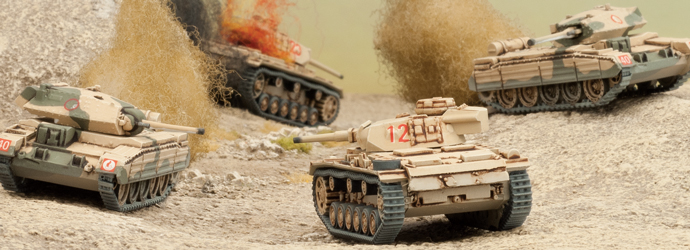
|
|
Changes
As always, with a new version of the game, some things change. We’ve taken the opportunity to improve things in a number of ways. The most obvious of that is the way in which units and equipment characteristics are presented and some of the ratings of certain units. With the introduction of unit cards, we removed some of the constraints of the old system, allowing us to replace endless special rules to modify characteristics with simple numbers. The Tiger tank for instance used to have the Mission Tactics, Wide tracks, Slow Tank, Protected Ammo, and Unreliable special rules. All of these are now wrapped into the numbers on the unit card.
|
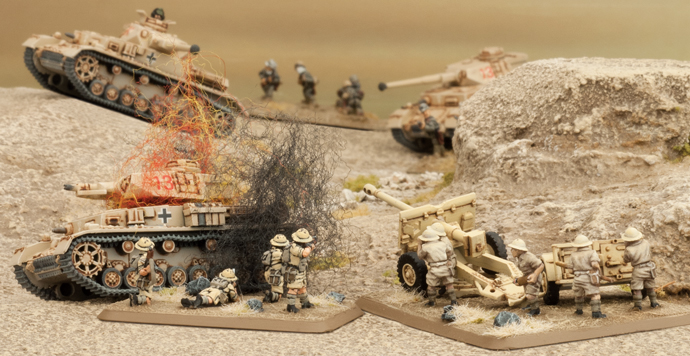 |
|
We were also able to get a little more detailed than before. The old rules had just four different types of tanks for movement (modified by lots of special rules). Now each tank has its own movement characteristics based on everything from its speed, horsepower, track width and ground contact, length, gun overhang, height, and even the number of road wheels. So for instance, the Panzer IV is slightly faster at crossing terrain than the smaller Panzer III with its less efficient suspension.
This detail is also evident in things like the ranges of guns, which are now in 4”/10cm increments rather than 8”/20cm increments. We also adopted a more detailed model of tank armour and gun penetration than the one developed 15 years ago. This has resulted in some minor changes in some of the characteristics. At the same time, we simplified some things that were just unnecessarily detailed. Now, most tanks just have one line covering all of their machine-guns, so you don’t have to look up a bunch of rules to find out which machine-guns can fire at what ROF – much easier!
|
|
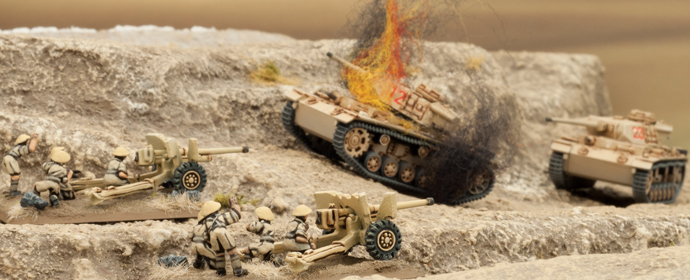
|
|
Some units have also changed their organisation, either because we have better information available than we had, or because we wanted to make them work better in the game. As an example, the Africa Rifle Platoon combines both of these. Long, long ago, back when the original Afrika Korps book was written, we assumed that infantry platoons in Africa were organised the same as those elsewhere. About eight years ago, we discovered that they were organised very differently, so in the North Africa compilation, we created a platoon structure that allowed players to either continue using their old organisation or the correct one. In the new Afrika Korps book, we’ve finally eliminated that long-ago error and put in just the correct organisation. Fortunately, all it does for players with existing forces is drop a few MG teams from their platoons. The new organisation also separates out the infantry and the guns into different units as this works better in the game.
Artillery and anti-tank guns have also changed their organisation as we’ve deleted the old command and staff teams. These did not play a significant part in the game. By dropping these teams, we make the units cleaner and simpler to model for players.
Having said all of this, the vast majority of things haven’t changed from what veteran players will be used to.
|
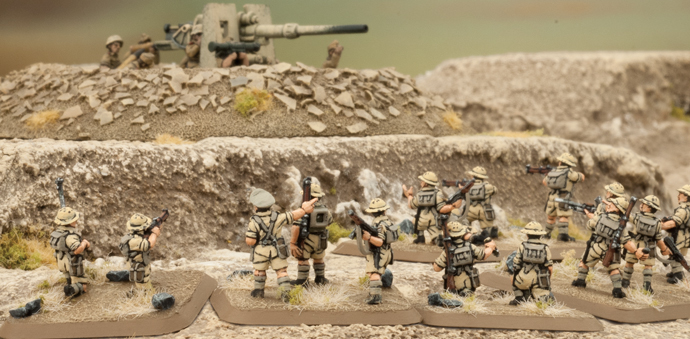 |
|
Transports
Another area where we have cleaned things up is in the area of transports, particularly unarmoured trucks and other transports. The new version of the game is faster playing and has more manoeuvre than the old game. As part of that, infantry and gun movement rates have increased. Combined with the lack of a penalty for moving at Dash speed compared with the double hits from the old At the Double, infantry now cross the table at a much higher speed.
This has reduced the need for trucks and the like considerably, so we decided to remove them from the forces. That way players collecting a force can focus their time and money on collecting shooty things that play a significant part in the game rather than trucks that are only seen occasionally on the table.
That’s not to say that trucks and their ilk are out of the game. The aforementioned Command Cards will give you the opportunity to add trucks to your force for those playing on large tables where they start to come into their own.
|
 |
|
An Exciting New Game
Thanks for reading these design notes. I hope they’ve left you excited to get into this new version of Flames Of War with the Desert Rats and Afrika Korps books.
~ Phil.
|
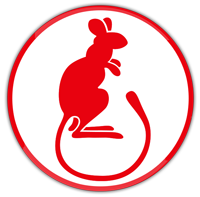 |
Desert Rats Design Notes
The Desert Rats are the only thing standing in the way of Axis conquest of North Africa. Despite suffering repeated defeats at the hands of Rommel’s Afrika Korps, they remain undaunted. Their speedy Crusader and Honey tanks can run circles around their opposition, backed up by the heavier Grant squadrons. Their motorised infantry are equally adept in attack or defence. With support from the Royal Artillery and the Desert Air Force, they are a formidable and versatile force. |
 |
Last Updated On Thursday, March 4, 2021 by Wayne at Battlefront
|
|